Feature Interview with Rich LaBar
February, 2021
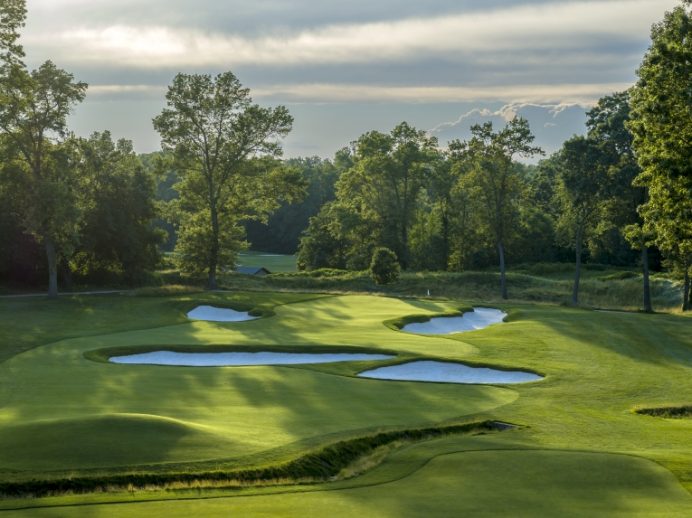
Quaker Ridge, just one of several high profile Tillinghast courses that LaBar has worked on (photo courtesy of Evan Schiller Photography).
1. You are based in Basking Ridge, NJ. How did you get into the golf course construction and renovation business?
Prior to his death when I was 12 years old, my father Richard S. LaBar Sr. regularly took me to his job. He worked for Hugh Hefner as an assistant superintendent at the old Playboy Club in Vernon, NJ. My father’s hard work and love for the game of golf created my early interest and then later, my foundation in the sport.
As a summer job during college, I was involved in the building of Crystal Springs Golf Club in Northern NJ. That helped kick things off for me professionally. After graduation from Rutgers University in Environmental Business and Economics, I worked for Gene Mulvihill building Black Bear Golf Club, Ballyowen Golf Club and Wild Turkey Golf Club — all in Northern NJ. I was hooked after that because I developed a relationship with someone (Gene) who believed in me and allowed me to learn on the job and make a few mistakes along the way….
Many years later, Gene continued as an important mentor for me when I launched LaBar Golf Renovations.
2. What are the list of services that LaBar Golf Renovations offers?
- Complete Golf Course Construction & Renovation
- Green Construction
- Hydronics Installation
- Sub Air Installation
- Precision Air Installation
- Bunker Construction
- Better Billy Bunker
- Capillary Concrete
- Bunker Solutions
- And other bunker liner materials
- Tee Construction
- Drainage, Drainage Master Plans
- Pond and wall work
3. Explain how your services roll up under those of an architect.
We assist in bringing the architect’s vision to reality. To take a plan on paper and turn it into something tangible that the members enjoy is our goal. It is a deeply satisfying profession.
4. Who hires you? I assume the club, based on the recommendation of their selected architect?
Yes, this is correct. Several factors help give clubs confidence in us, including the recommendation of their selected architect, our industry reputation and referrals from other clubs.
5. So you are employed by the club and work in the field to make the architect’s vision come true. What components must exist for a project to be successful?
Strong leadership, strong support team, and an excellent relationship with client and club representatives. Consistent weather is also hugely important.
6. Conversely, what can doom a project before you even get started? Have you ever walked away from projects because of false expectations?
If a Club has unrealistic budget expectations and/or time restraints, there would be too many obstacles. We have walked away from several projects including one with a very large, high profile club in December 2019. This club has hosted many majors and will host many more. I had a feeling as I went through the interview process that it wasn’t a good fit for my company. There were other opportunities and I decided to take on a significant Tillinghast renovation with Keith Foster at Brook Hollow Golf Club, Dallas TX instead. I thought the chemistry and fit was better and that is exactly how it turned out. Being presented with multiple opportunities inside a common time frame isn’t unusual. In general, we pick the jobs where we have the best chance to perform the kind of high quality work we like to do, inside the time frame that best fits our schedule.
7. There is no substitute for in-the-field experience. What have been a few lessons learned since you started your own firm in 2012?
It’s a relationship business.
*I personally develop relationships with all my clients.
*No two projects are ever the same.
*Always be prepared for curve balls.
*You are only as good as your team.
8. As your crew goes from one project to the next, how do you insure that the work doesn’t take on a similar look? For instance, Tillinghast’s work at Ridgewood shares little aesthetics in common with Raynor’s work at The Creek.

Raynor’s bunkering …
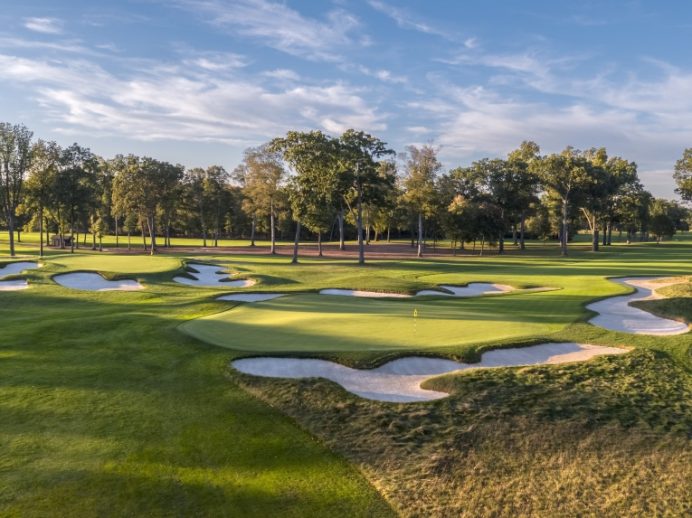
… and Tillinghast’s bunkering style bear scant resemblance (both photos courtesy of Evan Schiller Photography).
Hanse Design was responsible for the shaping at Ridgewood and The Creek, while we did the construction. At other projects where we are involved in the shaping, like at Brook Hollow and Oak Hill, we bring in talented project managers and shapers that can adjust and adapt to both classic and modern architect styles. We take great lengths to use our client resources (make numerous site visits, examine club archives and all available photography) to expose our shapers to similar features that the architect is looking for on a specific project. Also, we use historic plans from our clients to help our shapers adapt to the vision of the master plan. Personally, I’ve have spent a good amount of time studying the classic architects such as Tillinghast, Ross, Raynor, Colt, and Alison as well as the works of the several modern architects. I am always learning, which is both fun and beneficial.
9. You have done many high profile projects in the past decade, there are no shortage of topics to cover, so let’s begin. In 2019, you worked with Andrew Green at Oak Hill, a massive, high profile project. How did that go?
Oak Hill contracted us almost a year and half ahead of the start date. We had ample time to prepare for the project. Andrew Green was present on site every week throughout the project. His presence kept the job moving as we never had to slow down and wait for architect review of our work. Jeff Corcoran, Manager of Golf Course and Grounds, and his staff were directly involved with many aspects of the project, which enhanced the overall success of the project. It was a real team effort in every sense of the term, exactly the kind of situation we like.
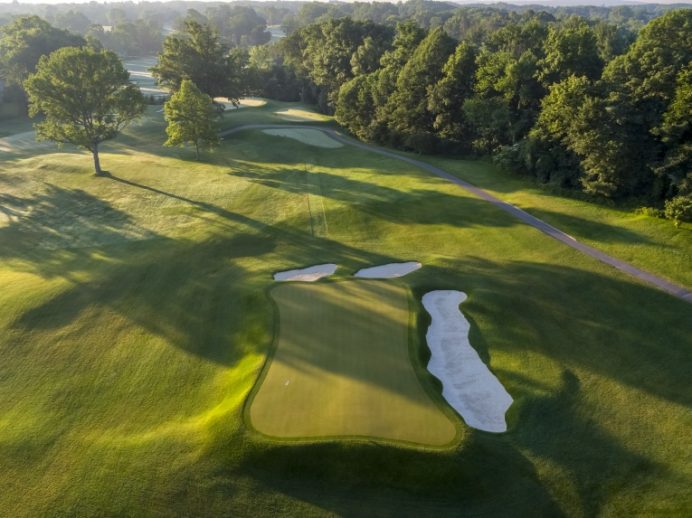
An ill conceived pond was eradicated from the right side of the 15th green at Oak Hill during the Andrew Green lead restoration in 2019 (photo courtesy of Evan Schiller Photography).
10. The growing season is short there. Give us an idea of the scope of manpower and equipment that was necessary to accomplish such an undertaking in a relatively short period of time.
We assigned 4 project managers, several shapers, foreman and operators and 65 laborers working in unison to execute and complete the project well before our contracted deadline. We had more than half of our company equipment inventory and a full-time mechanic also deployed at the project.
11. Wow! How do you maintain quality control in such a work environment where speed is essential?
Chain of command — having multiple project managers answering a project lead.
We are in the field full-time on all our jobs, measuring daily the quality and direction of every bit of work we do.
Field work is subject to all kinds of variables and surprises. We pride ourselves on being able to adjust and to go the extra mile.
12. What is an example of making an in the field adjustment that worked out well for all?
Most adjustments are rarely structural. On one job though, we were fairly adamant about not elevating a new tee box, believing that it wouldn’t fit nearly as well with the current hole. We made a strong case for not changing the tee shot’s visuals/depth perception. Ultimately, the tee was built without any artificial elevation and that proved to be the right call.
13. You have worked with Keith Foster at a couple of the finest courses in the middle of the country, namely Omaha CC and Brook Hollow. In the case of Brook Hollow and with Covid, that was a relatively slow build, was it not? What were the advantages of continuing to work through Covid when travel was so difficult, especially February-May?
We are very proud of the work and our association at Omaha and Brook Hollow. The onset of Covid did present many problems with the size of staff we had in Dallas. We took the pandemic very seriously and placed one of our managers in charge of implementing and enforcing policies and procedures as per the recommendations of the CDC and Dallas, TX.

Keith Foster’s work at Brook Hollow has restored the Great Hazard to the long par 5 15th hole.
14. You have worked with Gil Hanse at a number of household name courses from coast to coast in all kinds of different soil conditions. How does the soil impact your approach?
The soil is different at every club.
Weather is the biggest impact and causes more erosion and issues with sandier soils. For instance, we were very fortunate to spend over 8 months in Los Angeles and only had one rain day.
Light rains are manageable on all soils, while heavy rains produce time-consuming delays on every type soil.
15. Another super high profile course that you attacked last year was Muirfield Village. How was working with Nicklaus Design? Based on the work done, what should we look for this year at the Memorial on television?
We absolutely loved working with Nicklaus Design. It was such an important job to Jack and team. The Muirfield Village project was amazing as the Club and property is filled with a lot of history. Covid through us a curve-ball on this project when the Tournament was postponed 6 weeks so we had to adjust our schedule to complete a major restoration in less time.
Look for a much tougher test for the tour professionals. Jack put much thought into every change made to each hole, with an eye to maintaining the challenge for tournament golf. Nearly every change made there was done with that goal in mind and I have no doubt that Muirfield Village will forever remain one of the best host sites for major professional events.
My personal favorite change is the significant amount of work done to the 15th hole. The fairway was lowered more than 15ft, bunkers were added along the right of the fairway and the green was brought closer to the creek. The hole will produce fireworks come the Memorial, which will be fun for all of us to watch.
Personally and as a complete aside, the Club is dear to my heart as I won the 3-day member guest (Bearfoot Classic) in June 2019 with my friend and Club member, Kevin Shanahan.
16. You install Better Billy Bunker, Bunker Solutions and Capillary Concrete. When do you recommend which solution?
They are all great products, and we have had great success with each. The decision on which products to be used are almost always made between the architect, club and their superintendent. Rarely, if ever, do we express a preference. We are good to go using whatever they select.
17. Speaking of bunkers, the best I have seen recently are at Hollywood GC in New Jersey. Tell us about that project with Brian Schneider and Renaissance Design.
Brian Schneider has a passion for Walter Travis designed golf courses — and it was really cool to be a part of the project along with him in the fall of 2013 and spring of 2014. We are currently restoring the 17th hole with Brian which he has wanted to do for many years. We think the work at Hollywood GC is a perfect example of an architect’s talent and interpretative vision and our construction skills.
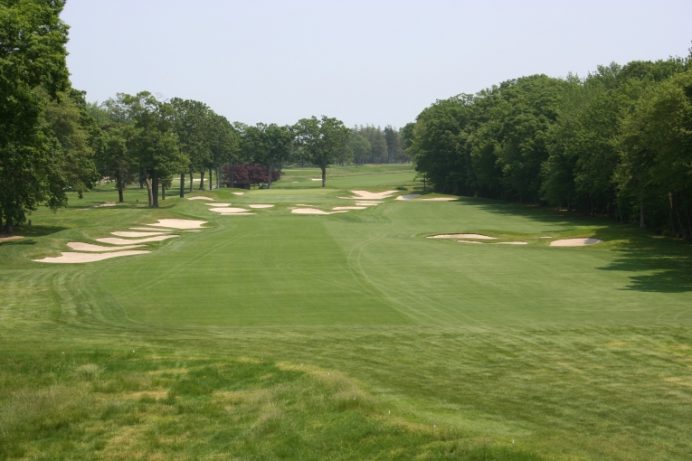
The difference between good and …
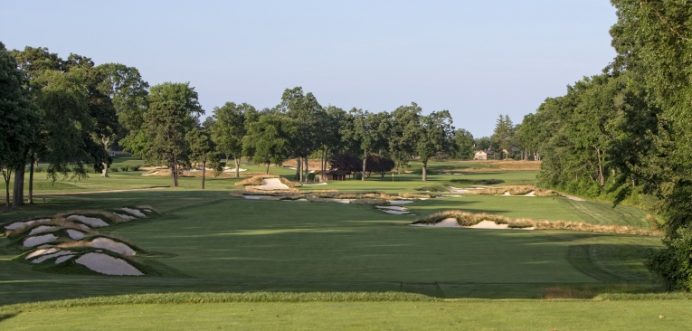
… great is evident in these before and after pictures of the 12th at Hollywood GC.
18. What were some of your most memorable jobs/experiences?
That’s easy. Our first major job was the practice areas at Winged Foot, which was soon followed by the renovation of Winged Foot’s East Course. That put us on the map and other famous clubs then became comfortable in selecting us. Working closely with Steve Rabideau, Winged Foot’s talented Superintendent, was a real pleasure. Ultimately, we worked on their famed West Course ahead of the 2020 U.S. Open. Winged Foot is always going to be a happy memory, what a great facility.
This past summer, we were called in by Oakland Hills to help finish their grand restoration project. In seven weeks, we delivered a terrific result and it was personally gratifying to get that job completed in such a short time frame. We were like a “hired hit squad” as we were in and out quickly.
19. Why should a club hire LaBar Golf Renovations?
We pride ourselves on our reputation and that most of our clients return— and many new clients come via referrals. We have very low turn-over. Our project managers, operators, foreman and laborers have been with us since the start. Most architects know our key staff members by name and request them for specific projects. Provided that we have ample lead-time, we almost always accommodate their request. This all points to having strong relationships and executing great work for our clients.








